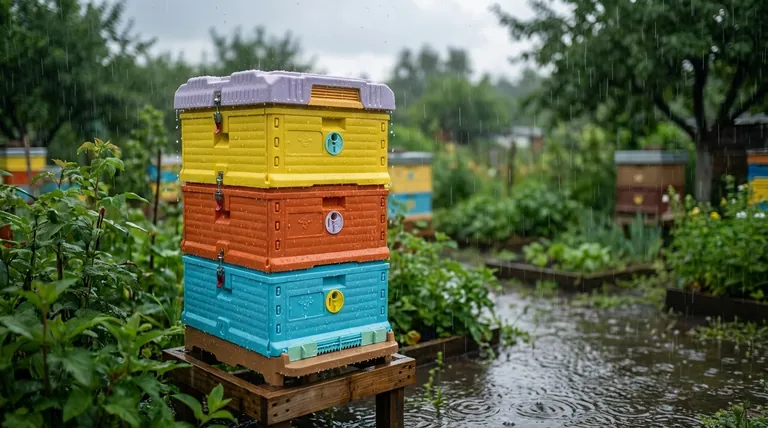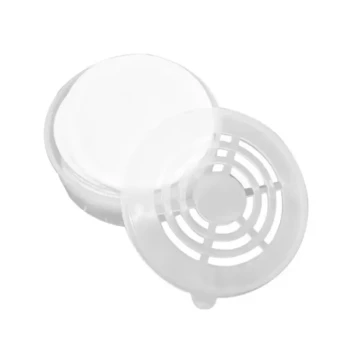Ultimately, plastic beehives are completely waterproof from the outside. Due to the non-porous nature of the material, rain, snow, and dew cannot penetrate the hive walls or roof. This provides an excellent external barrier that keeps the colony shielded from the elements and prevents the structural rot that can affect wooden hives.
The core advantage of plastic is its complete impermeability to external moisture. However, this same quality creates a critical challenge inside the hive: managing condensation produced by the bees themselves.

The Core Advantage: An Impermeable Shell
A plastic hive's ability to shed water is one of its primary design strengths. This benefit stems directly from the fundamental properties of the material.
The Nature of Plastic
Plastic is a non-porous material. Unlike wood, which can absorb and retain moisture, plastic forms a solid barrier that water cannot soak into or pass through.
Protection from External Moisture
This impermeability means that a plastic hive effectively repels all forms of external precipitation. Rainwater sheets off the surface, ensuring the interior cavity remains dry during storms.
Preventing Material Degradation
Because plastic does not absorb water, it is immune to the rot, warping, and fungal growth that can degrade wooden hives over time, especially in damp climates. This significantly increases the hive's lifespan with minimal maintenance.
Understanding the Trade-offs: The Condensation Challenge
While plastic's waterproof nature is a benefit, it creates a significant internal management challenge that is less pronounced in wooden hives.
The Problem of Internal Moisture
A colony of bees releases a large amount of warm, moist air through respiration. In a porous wooden hive, some of this moisture can be absorbed by the wood and slowly dissipate. In a sealed plastic hive, this vapor has nowhere to go.
How Condensation Forms
As the warm, humid air rises from the bee cluster, it makes contact with the cold inner surfaces of the hive, particularly the inner cover and top. This temperature difference causes the water vapor to condense into liquid droplets.
The Risk to the Colony
These cold water droplets can drip back down onto the bee cluster. This can fatally chill the bees, especially during the critical winter months, and foster a damp environment that promotes mold and other pathogens.
Managing Moisture in a Plastic Hive
Success with plastic hives hinges on actively managing the internal moisture that the bees produce. Without proper strategy, the hive's waterproof nature can become a liability.
Ventilation is Non-Negotiable
Adequate ventilation is the single most important factor. An upper entrance or ventilated inner cover allows the warm, moist air to escape the hive before it has a chance to condense.
Using Moisture Boards or Quilt Boxes
Many beekeepers place a "quilt box" on top of the hive. This is a shallow box filled with an absorbent material like wood shavings, which wicks moisture out of the air while still providing insulation.
Proper Hive Placement
A simple but effective technique is to slightly tilt the entire hive forward. This ensures that any condensation that does form on the inner walls will run down to the front and out the entrance, rather than dripping directly onto the bees.
Making the Right Choice for Your Climate
Your decision should be based on your environment and your willingness to manage the hive's internal atmosphere.
- If your primary focus is durability in a wet climate: A plastic hive is an outstanding choice for its ability to withstand constant rain with zero risk of rot.
- If your primary focus is winter survival in a cold climate: Plastic can be very effective, but only if you are committed to providing robust ventilation and moisture control to prevent condensation.
- If your primary focus is a more forgiving, "breathable" hive: A traditional wooden hive, while requiring more maintenance, naturally manages some internal moisture, which can be an advantage for beginners.
By understanding that plastic hives trade external waterproofing for an increased need for internal ventilation, you can make an informed decision and provide a secure, dry, and long-lasting home for your colony.
Summary Table:
| Aspect | Plastic Hive Performance |
|---|---|
| External Waterproofing | Excellent; completely impermeable to rain and snow. |
| Internal Condensation | High risk; requires active ventilation and moisture management. |
| Material Durability | High; immune to rot, warping, and fungal decay. |
| Best For Climates | Wet climates where external moisture is a primary concern. |
| Key Consideration | Mandatory upper ventilation or use of a quilt box is critical. |
Ready to equip your apiary with durable, high-performance hives?
At HONESTBEE, we supply commercial apiaries and beekeeping equipment distributors with the robust supplies needed for success. Whether you're considering plastic hives for their superior waterproofing and longevity or need comprehensive equipment solutions, our wholesale-focused operations are designed to support your business's growth and efficiency.
Let's discuss the best hive options for your specific climate and operational needs. Contact our expert team today to request a quote or learn more about our product range.
Visual Guide

Related Products
- Professional Insulated Plastic Bee Hives
- HONESTBEE Professional Long Handled Hive Tool with Precision Cutting Blade
- 7 x Auto Bee Flow Hive Frames Plastic Beekeeping Hive Box Supplies
- Yellow Plastic Bucket Pail Perch for Beekeeping
- Honey Flow Garden Bee Hive Flow Hive Best Beehive for Beginners
People Also Ask
- Why is it recommended to buy at least two bee hives? Boost Your Success with a Second Colony
- Is polystyrene bee hive better than wood? Superior Insulation for Healthier Bees & More Honey
- How much additional time does having more hives require? Master Efficient Apiary Management
- What are the environmental benefits of EPS bee hives? Boost Colony Health and Reduce Your Eco-Footprint
- What are the advantages of plastic bee hives? Boost Efficiency & Durability for Your Apiary



















